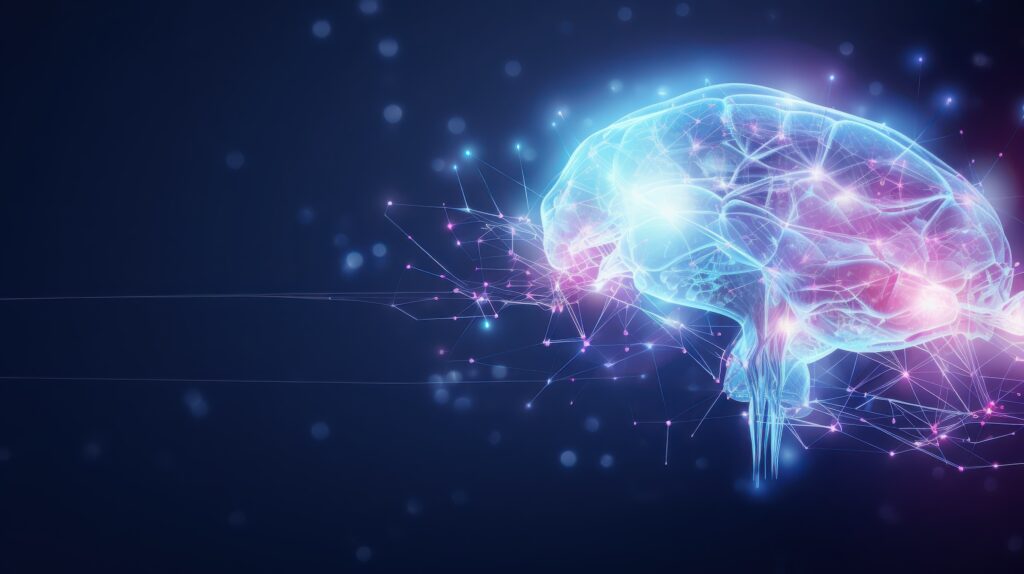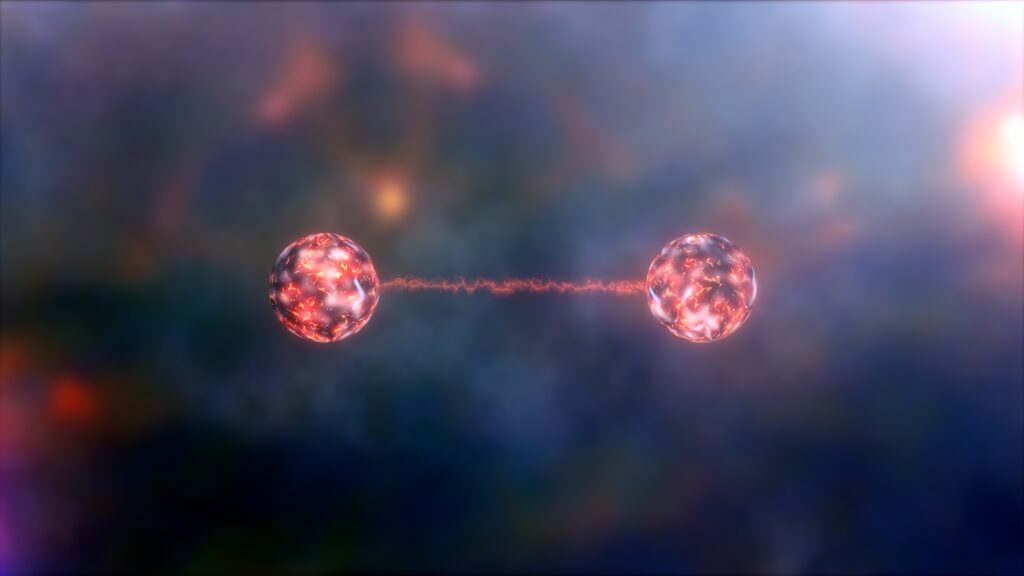Dissociation and complexity: A psychiatrist’s perspective
Reading | Psychiatry
![]() Yulia Perch, MD | 2021-07-01
Yulia Perch, MD | 2021-07-01

Analytic Idealism’s claim that individual human consciousness is a segment of a universal mind, separated from it via dissociation, is supported by the neurobiology of Dissociative Identity Disorder (DID), according to psychiatrist Dr. Yulia Perch. In this essay, complexity science and Dr. Perch’s own clinical experience are used to demonstrate that dissociative processes in a living psyche are not specific to DID, but widespread and inevitable.
As a psychiatrist, I often imagine the mind as an old forest, dangerous and full of treasures. I’ve spent so much time in this ‘mindscape’ that I developed something I would call ‘a geometrical feel’ for it. I know, by direct experience, that the mind is rugged terrain, unpredictable but precisely patterned, composed of an infinite number of moving parts, sometimes disjointed, sometimes harmonious, sometimes beautiful, at other times monstrous. The language of complexity science has a one-word equivalent to my long-winged poetic ramblings: fractal.
The mind is also immaterial. This is self-evident, but we can’t help but speak of ‘beautiful mind,’ ‘heavy thought,’ ‘warm feeling.’ We describe an entity wholly inaccessible to our sense-perceptions in sense-perception terms. And then we forget that these expressions are allegorical. I believe that the idea of dissociation as an omnipresent generative force within the psyche would not feel so alien if we explicitly maintained that the mind is not a thing. It need not break to give rise to a great variety of distinct parts. And if the mind is not a thing, what is it?
The mind is a process. The way we experience life—our thoughts, feelings, sensations—are in a state of constant flux, just like life itself. The mind is always in motion, changing from one instant to the next, like a proverbial river in which no man can step twice because it’s not the same river, and he’s not the same man. Complexity science calls such process-entity a Nonlinear Dynamical System (NDS).
Nonlinearity is not unique to the human mind but is found everywhere—in clouds, forests, waterfalls, the spread of the pandemic. It is in our bodies, our cities, stock markets, Twitter, ‘Arabian Nights’ and virtually any system that endures and evolves. All NDSs, physical or not, share common characteristics and abide by specific rules.
By definition, an NDS is a whole composed of many parts (subsystems) that behave more or less autonomously. A system with more autonomous subsystems is said to possess more degrees of freedom. The more degrees of freedom the system has, the more flexible it is and more resilient. Systems with infinitely many degrees of freedom (consciousness, waterfall) are incredibly robust, maintaining their overall integrity against a tremendous amount of perturbation. In a sense, such systems are indestructible.
In NDS, such as the mind, there is no homogenous whole. The whole is its many parts. These parts, called alters, variables, degrees of freedom, agents, archetypes, can synchronize and act as one (associate) or de-synchronize and act independently (dissociate). When parts of the system are highly dissociated, its entropy increases and the system may enter a period of chaos. Then, within the chaos, dissociated and unstable subsystems begin to self-organize into distinctly ordered structures. Chaos is a precondition for order and necessarily precedes it. Order exists as constrained chaos.
Dissociation, thus, is inherent in the very nature of nonlinear systems. Without it, the system would cease to have any meaning. Therefore, the dissociative processes within the mind, both individual and universal, are not only possible but inevitable. A network of dissociated parts is what the mind is.
An objection to Analytic Idealism—the notion that human minds are dissociated segments from one universal mind, which underlies all reality—stems from the popular perception that Dissociative Identity Disorder is the only clinical manifestation of dissociation. In reality, dissociation is far more common and a lot less dramatic, existing on the continuum from pathological to normal, from adaptive to maladaptive.
Hereafter I propose a taxonomy of dissociation based on the degree of autonomy (degree of freedom) established by the dissociated parts. In the spirit of complexity science, I emphasize that these are not exact categories but large-scale overlapping patterns spread over the many dimensions of the psyche.
- Near-complete dissociation. Dissociated parts are highly autonomous and unstable. The personality is discontinuous, lacking overall coherence. Dissociative Identity Disorder (DID), acute psychosis and temporal lobe epilepsy (TLE) are examples of near-complete dissociation. In these disorders, the normal dynamics of the mind are severely disrupted and manifest in disabling symptoms, such as the co-existence of two or more personality alters in DID; fragmentation of thoughts and perceptions in psychosis; “absence seizures” in TLE. Mathematical analysis of EEG, EDA and fMRI data in acute phases of these disorders shows an increase in brain entropy followed by self-organization, suggesting that this process may be a bio-dynamical correlate of dissociation. Another characteristic feature of near-complete dissociation is that metacognition cannot capture it in a rational, coherent narrative, either because it is itself impaired or because the surrounding disorder is too great. As a result, the subjective report of these states is either severely distorted or altogether absent (a condition known as “anosognosia”). Without intervention, these disorders rarely, if ever, remit.
- Partial dissociation. Dissociated parts exhibit significant autonomy, but the overall coherence of the personality is preserved. The subjective experience of partial dissociation is within the grasp of metacognition. Patients report distressing symptoms such as fogginess, fatigue, flashbacks, disorientation, depersonalization. These states are self-limiting but can significantly decrease the quality of life. They are common features of anxiety disorders, especially PTSD and Panic Disorder. Conversion Disorder is a special case of partial dissociation. It includes a fascinating array of so-called “functional neurological impairments,” such as non-epileptic seizures, psychogenic blindness, sensory and motor function loss. I once worked with a patient with psychogenic aphasia, the loss of speech. The nature of the disorder is thought to be dissociative, with no ‘organic’ changes in the brain. The dissociative dynamics have also been postulated to play an important role in addiction, severe depression and bipolar disorder.
- Subtle dissociation (re-association). The mind’s subsystems have some autonomy but act harmoniously, assembling and disassembling in response to the environment’s demands. Our everyday roles—spouse, parent, best friend—all comprise a personal repertoire of adaptive dissociations and reflect the overall flexibility and richness of the psyche. The subjective experience of subtle dissociation is a sense of mastery and overall well-being. A particular case of adaptive dissociation is personality shifts in bicultural bilinguals. Being one myself, I can attest to the striking change in my self-perception and how I relate to the world when I change the language I use. Certain traits become dominant and others go underground. The personality that speaks a certain language is more fit for the culture of that language.
Analogous to the dissociation within an individual mind, the dissociation within universal consciousness depends on the degree of autonomy (degree of freedom) established by the dissociated alter—the human mind. The degree of autonomy, in turn, is determined by the dominance of explicit metacognition.
We know from neuroimaging studies that neural networks associated with metacognition are present in a rudimentary form in animals and young children but do not reach a level of maturity sufficient to support explicit introspective thinking until the age of 7-9. Thus, explicit metacognition appears to be a uniquely human function that is not present at birth but develops and matures over time. In contrast, phenomenal consciousness, or the ability to experience (feel pain, hear thunder), is as widespread as life itself.
Dynamically, metacognition may be viewed as an autonomous subsystem of the mind, emerging within the mind via self-organization. Compared to the infinite richness and complexity of universal consciousness, metacognition is a highly constrained system and, as a result, it is inflexible, not very resilient and information-poor. It is a precious evolutionary acquisition, but we know from experience and research that metacognitive strategies are limited and highly prone to error. They may be weakened or extinguished by as little as sleep deprivation, alcohol or a blow to the head.
Thus, phenomenal consciousness is a given; metacognition evolved from it. When we cognize, we are not experiencing as much as otherwise possible. Metacognition implies distance from our core subjectivity. When we engage in metacognition, we are further removed from universal consciousness.
In near-complete dissociation, explicit metacognition is overdeveloped and exerts tight control over the personality. Instinctinctual energy is diverted to maintain the ego’s illusion of omnipotence. The feeling of authentic connection with the world and empathy towards other living beings is rarely experienced, if at all.
Indeed, near-complete dissociation appears to be a core pathology in Obsessive-Compulsive, Dependent, Schizoid, Schizotypal and Paranoid Personality Disorders. In these disorders, the ego structure is exceptionally rigid and resists change. As a result, the perception of the world is heavily distorted. The experience of life is impoverished, monotonous, lacking novelty and meaning. The subjective report of patients with Personality Disorders, if we ever get to hear one, is that there is nothing wrong with them, but everything is wrong with the world.
More commonly, we experience near-complete dissociation as a transitory state. When we are immersed in a demanding cognitive task such as writing an essay or preparing a tax return, we naturally lapse into near-complete dissociation. Activated metacognition is like a gravitational pull that captures psychic resources needed for a task. It’s hugely effective as a tool and we came to regard it as our human super-power. But it carries an inherent risk of taking too much control. Like Narcissus, we may become possessed by our reflection and deaf to the calls of beautiful Echo.
Complexity science calls such predicament “phase locking.” Phase locking into a single mode (as in a highly focused cognitive task) forces the system into a “periodic state”—a monotonous, repetitive sequence, depleted of information and meaning. As a result, the system becomes effectively enslaved, unable to adapt and, ultimately, survive.
I believe this may be the root cause of modern suffering. Our malignant bureaucracies, our brutally over-regulated workplaces, our obsession with goals, schedules and productivity quotas are the symptoms of a kind of ‘dynamical sickness.’ Our educational system is the saddest of its victims. Seeing it in action, I’m quietly horrified at the mentally mutilated humanoid entities it aims to produce.
Overdeveloped, malformed metacognition leads to sustained dissociation from universal consciousness. The price we pay for these ‘achievements’ is depletion of life force and tragic impoverishment of life experience.
Our reflection does not love us back and never will. Like Narcissus, we will perish unless we find the strength to turn away.
In partial dissociation, ego-consciousness is sourced in universal consciousness, but the awareness of their connection is obscured. An individual is generally well-adjusted and not overburdened by existential concerns. Everything is seen through the lens of one’s identity. The illusion of control is maintained, but the ego is open to the challenges emerging from the transpersonal unconscious. This is our everyday, ordinary state. Sadly, this ‘normal’ state is becoming more of a luxury in the West today for the reasons described above.
In subtle dissociation (re-association), the individual mind is aligned and deeply resonant with universal consciousness. The ego-boundaries become fuzzy or dissolve. The sense of one’s identity expands. We are immersed in immediate experience. We are deeply perceptive. We feel surges of rich, powerful emotions that may take us to the heights of ecstasy or plunge us into despair. Our imagination flows unimpeded. Spontaneous visions may arise. We are now fully aware of our connection to the universal mind. Our metacognition does not constrain us.
We associate these states of consciousness with meditation, shamanic trance, mystical experiences, psychedelic trips and regard them as rare moments of profound significance. But I would argue that they are not that uncommon, and most of them do not involve consumption of exotic plants or prolonged chanting.
The mind of young children, and perhaps some elders, is essentially non-dual. But even the lives of ordinary adults are punctuated by spontaneous re-association moments: a creative insight, a flight of imagination, one magnificent sunset or a tragic loss. Deep love and deep suffering are universal and the most potent transpersonal experiences.
The problem is that we can no longer recognize them as such because our mainstream materialist culture dismisses them as by-products of brain activity, useless at best, illegal at worst. The cultural container in which these states could find meaning and be integrated has been destroyed. As a result, we are lost, haunted more than ever by the ghosts of our loves and sufferings.
Like re-association within the individual mind, re-association within universal consciousness can be sustained and become an enduring trait in artists, musicians, writers, sages, serious scientists and philosophers. In addition, the presence of personality traits such as empathy and sensitivity suggest an inborn proclivity for a stronger connection with universal consciousness.
However, re-association with universal consciousness without appropriate metacognitive mediation can overwhelm the ego and manifest as impulsivity, disinhibition, emotional dysregulation. We all experience it when we are tired, stressed or in pain. In more severe form, it’s present in ADHD, Borderline Personality Disorder, some brain injuries and many other physical and mental ailments.
In summary, the psychic life of human beings is a continuous, dynamic process of dissociation and re-association, within itself and with universal consciousness. We occupy the intermediate place in this hierarchy of dissociations, with countless subsystems within us and us being subsystems in the infinite network of the universal mind.
It’s hard to fathom the complexity of such an entity. J. Gleick, in his book, Chaos: making a new science, describes it as “hydra; merciless, uncontrollable.” Known by many names since antiquity (Self, Will, Pleroma, Brahman), this is the “whole that is greater than the sum of its parts.” Yet, modern neuroscience has no name for this whole. And because there is no name for it, we act as if it did not exist. As Jung predicted, we now have psychology without the psyche. And we seek to explain the unfathomable complexity of human inner life with a myth of “chemical imbalance.”
This myth is not wrong. Biochemistry is real; psychotropic medications do help and can be lifesaving. But its overall explanatory power is weak. First, it assumes that knowledge of the mechanics of the brain will result in the understanding of the mind. Then it goes on to commit the mistake of applying linear methodologies to a nonlinear system.
A ‘new and updated’ myth would not discard the existing knowledge but build on it. In addition to material objectivity, we would begin to study immaterial subjectivity. Analytic Idealism gives us a name for this subjectivity: universal consciousness. Complexity science gives us new and powerful tools. We need to study the mind as a nonlinear dynamical system. We need to study the process, not a thing. And we study the process not by dissecting it or building models of it but by interacting with it. In the Red Book, Jung wrote: “One eye of Godhead is blind, one ear of Godhead is deaf, the order of its being is crossed by chaos.” We’ve studied “its order” for a long time. Perhaps, it’s time we started looking at “its chaos.”
In the language of complexity, a philosophical theory is a “strange attractor.” In the last 300 years, materialism grew into a very powerful attractor with a gigantic basin. Today, Analytic Idealism is materialism’s “adjacent possible”—a smaller attractor that forms at the boundaries of the larger one as the alternative that may one day surpass it. Steven Johnson describes it as “a kind of shadow future, hovering over the edges of the present state of things, a map of all the ways in which the present can reinvent itself.”
The system—our human world—is changing the attractors. The adjacent possible is growing. But growth happens at the edges. Boundaries grow as we explore them. By capturing more variables, more degrees of freedom, the attractor becomes more complex, its robustness increases. In other words, the attractor becomes more ‘attractive’ as it accumulates meaning. Exploration unconstrained by goals is the key. The change comes as we explore its meaning.
References
Bob, P. Dissociation, Epileptiform Discharges and Chaos in the Brain: Toward a Neuroscientific Theory of Dissociation, Act Nerv Super 54, 84–107.
Gardiner, J. (2013) Fractals and the irreducibility of consciousness in plants and animals, Plant Signaling & Behavior, 8:8, e25296, DOI: 10.4161/psb.25296.
Glattre, H. Glattre, E. (2018) Finding Fractal Networks in Literature, Nonlinear Dynamics, Psychology, and Life Sciences, Vol. 22, No. 2, pp. 263 – 281.
Gleick, J. (2008) Chaos: making a new science. Penguin Group. New York.
Guastello, J. S. Koopmans, M. Pincus, D. (2009) Chaos and Complexity in Psychology: The Theory of Nonlinear Dynamical Systems. Cambridge University Press. New York.
Hoffman, D. (2019) The Case Against Reality: Why Evolution Hid the Truth from Our Eyes. W.W. Norton & Company, New York.
Jung, C. G. (1969) The Archetypes and the Collective Unconscious. Princeton University Press, New York.
Karwowski, W. Sapkote N. Servi, L. Ahram, T. Schmorrow, D. Guitierez, E. (2020) Evidence of Chaos in Human Emotions Expressed in Tweets, Nonlinear Dynamics, Psychology, and Life Sciences, Vol. 24, No. 4, pp. 475 – 497.
Kastrup, B. (2011) Dreamed Up Reality: Diving into mind to uncover the astonishing hidden tale of nature. Iff Books. Washington, USA.
Kastrup, B. (2019) The Idea of the World: A Multi-Disciplinary Argument for the Mental Nature of Reality. Iff Books. Washington, USA.
Rosen, D. (2016) Accessing Creativity: Jungian Night Sea Journeys, Wandering Minds, and Chaos, Nonlinear Dynamics, Psychology, and Life Sciences, Vol. 20, No. 1, pp. 117-139.
Snowden, D. (2020) Cynefin – Weaving Sense-Making into the Fabric of Our World. Cognitive Edge—The Cynefin Co., Syngapore.

Essentia Foundation communicates, in an accessible but rigorous manner, the latest results in science and philosophy that point to the mental nature of reality. We are committed to strict, academic-level curation of the material we publish.
Recently published
Reading
Essays
Seeing
Videos
Let us build the future of our culture together
Essentia Foundation is a registered non-profit committed to making its content as accessible as possible. Therefore, we depend on contributions from people like you to continue to do our work. There are many ways to contribute.















